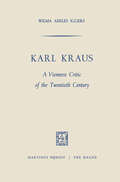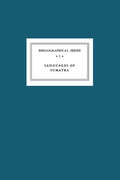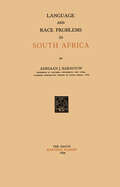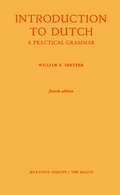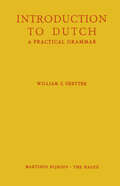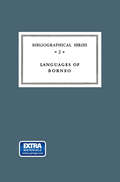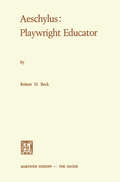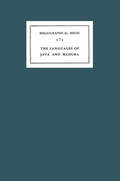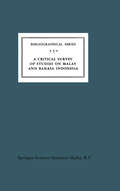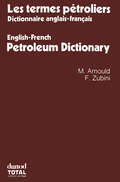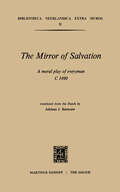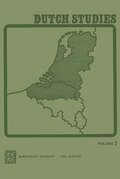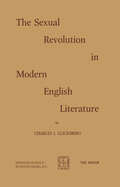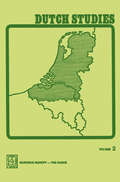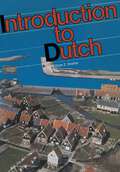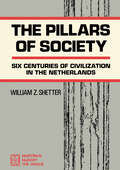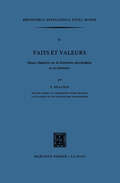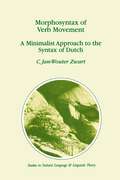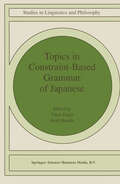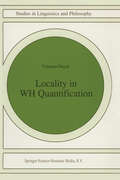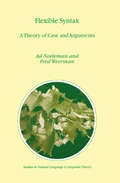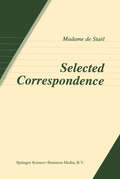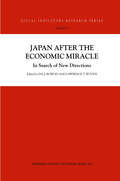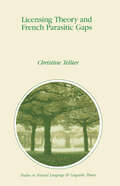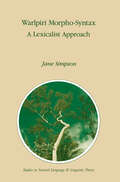- Table View
- List View
Critical Survey Of Studies On The Languages of Sumatra (Koninklijk Instituut voor Taal-, Land- en Volkenkunde)
by P. VoorhoeveThe aim of the critical bibliographies, compiled on the initiative of the Board of Directors of the Royal Institute of Linguistics, Geography and Ethnology, is to draw attention to the data on Indonesian lin~ guistics and cultural sciences collected in the past, and to provide guidance in this field. It so happens that these data were often published in journals with a limited circulation, whilst these journals are only available in a few places. Moreover, most of them are only accessible without difficulty to those workers in the fields of Indonesian linguistics and cultural sciences who possess some knowledge of the Dutch language. Apart from providing information, these bibliographies also have an other object, viz. to prevent that meritorious scholarly work would be lost due to the purely fortuitous circumstance - which, however, in actual practice is unfortunately of decisive importance - that this work is not written in a world language and that it cannot be every where easily consulted. The Board therefore hope at the same time to break with the slightly provincialistic nature which for evident reasons used to be characteristic for the studies in language and culture of Indonesia. The Board hope to be able to prevent that new research should have to start unnecessarily again at the very beginning, and also to contribute to a more rapid progress of scientific research in this field by means of a regular publication of these critical reviews of pubIications.
Introduction to Dutch: A Practical Grammar
by William Z. ShetterFirst edition This grammar arose from the need for a concise presentation of the essentials of the Dutch language which could be used both for independent home study and in groups or classes under formal instruction. With the former aim in mind, the explanations have been made as self-explanatory as possible, and a complete key to the exercises has been provided in an appendix. In the interest of simplicity and ease of reference and review, each grammatical topic is discussed as fully as practicable in one place, and an effort has been made to include only one major grammatical feature in any one chapter. But since a solid foundation can more effectively be achieved through study under trained supervision or with a native speaker of the language, the presentation has also been made adapt able to this type of study. The brief fill-in exercises in each lesson provide a model for any amount of drill, and the dialogues and readings included at irregular intervals as well as the review selec tions placed after every few chapters can provide the necessary added practice in supervised instruction. Help should in any case be sought with the pronunciation, the principal stumbling-block in the way of either independent or supervised study.
Introduction to Dutch
by William Z. ShetterThis grammar arose from the need for a concise presentation of the essentials of the Dutch language which could be used both for independent home study and in groups or c1asses under formal instruction. With the former aim in mind, the explanations have been made as self-explanatory as possible, and a complete key to the exercises has been provided in an appendix. In the interest of simplicity and ease of reference and review, each grammatical topic is discussed as fully as practicable in one place, and an effort has been made to inc1ude only one major grammatical feature in any one chapter. But since asolid foundation can more effectively be achieved through study under trained supervision or with a native speaker of the language, the presentation has also been made adaptable to this type of study. The brief fi11-in exercises in each lesson provide a model for any amount of drill, and the dialogues and readings inc1uded at irregular intervals as weIl as the review selections placed after every few chapters can provide the necessary added practice in supervised instruction. Help should in any case be sought with the pronunciation, the principal stumbling-block in the way of either independent or supervised study.
Critical Survey of Studies on the Languages of Borneo (Koninklijk Instituut voor Taal-, Land- en Volkenkunde #2)
by Anton Abraham Cense E.M. UhlenbeckAt the completion of this bibliography, the second of the planned series on language study in Indonesia, the authors acknowledge with gratitude the kind assistance of Father Donatus Dunselman, Dr A. H. Hill and Dr P. Voorhoeve who have read all or part of the manuscript. Also our heartfelt thanks are due to those who have provided us with information indispensable for the compilation of the bibliographical data, or have given us the opportunity to inspect their archives for linguistic literature on Borneo, i.e. the very Rev. A. Antonissen, Jesselton, North Borneo, Father W. Boon, Rector of the Catholic Mission, Mukah, Sarawak, Dr N. C. Scott, the Society for promoting Christian Knowledge, London, the British and Foreign Bible Society, London, the School of Oriental and African Studies, London, the Basle Mission, Basle, Switzerland, the Rhenish Mission, Wuppertal, Germany, the Dutch Bible Society, Amsterdam. The authors greatly appreciate the grant from the Netherland Institute for International Cultural Relations which made this public ation possible.
A Critical Survey of Studies on the Languages of Java and Madura: Bibliographical Series 7 (Koninklijk Instituut voor Taal-, Land- en Volkenkunde #3)
by E.M. UhlenbeckAt the completion of this critical bibliography which forms another step in the direction of the realization of the bibliographical project inaugurated in 1955 by Dr. Voorhoeve's survey of the languages of Sumatra, I acknowledge with gratitude the valuable assistance received from various people. I am indebted to my colleagues Prof. Dr. G. W. J. Drewes, Dr. J. Noorduyn, Dr. Th. Pigeaud, Prof. Dr. A. Teeuw and Dr. P. Voorhoeve, who read all or part of the manuscript and who generously put their extensive knowledge of the Java languages at my disposal. Heartfelt thanks are due to Mr. B. J. Hoff and Mr. A. G. Sciarone, both members of my staff, who verified many of the biblio graphical details. I am grateful to the library of the University of Leiden and to the library of the Institute in The Hague because of their readiness in giving me all the facilities I needed for the preparation of this book. Most useful was the cordial assistance received from my colleague Prof. Dr. P. E. de Josselin de Jong, who spent much time correcting the many imperfections of my English text, which greatly promoted the readability of the narrative sections of this survey.
A Critical Survey of Studies on Malay and Bahasa Indonesia: Bibliographical Series 5 (Koninklijk Instituut voor Taal-, Land- en Volkenkunde #5)
by A. TeeuwIn this book I have aimed at completeness in the sense that all publications known to me, which are wholly or partly devoted to Malay and Bahasa Indonesia (B.I.), or are important for the study of these languages, have been included. Popular publications in non-professional periodicals have been included only exceptionally. All the publications mentioned in the text are incorporated in the Bibliography (p. 91-157). The countless articles in four post-war, semi-professional periodicals in :'1alaya and Indonesia, Dewan Bahasa, Pembina Bahasa Indonesia. 11:1 edan Bahasa, Bahasa dan Budaja, are not mentioned separately in the Bibliography, but sections 33 to 36 contain a survey, as complete and systematic as possible, of the contents of these periodicals in so far as they pertain to the Malay language; nor have I discussed in the text or incorporated in the Bibliography several hundreds of titles of practical textbooks or school-books of Malay or B.I. which are of no importance to the scientific study of these language. These titles have been entered in a separate Appendix (p. 158--171). The fact that completeness was aimed at certainly does not mean that it has been achieved. Especially various recent writings from Indonesia and Malaya may have escaped my attention. Experience has also proved that publications on Malay sometimes appear in the most unexpected places. The qualification above: "publications ... devoted to ... , or impor tant for the study of" Malay and B.I. has been taken in a wide sense.
Les termes pétroliers: Dictionnaire anglais-français. English-French Petroleum Dictionary
by Michel Arnould Fabio ZubiniThe Mirror of Salvation: A Moral Play of Everyman c. 1490 (Bibliotheca Neerlandica extra muros #2)
by Adriaan J. BarnouwIn two world wars waged within the life time of one generation Death reaped a prolific harvest. His most formidable scythe in former days was not war but pestilence. But since medical science has forged all kinds of weapons wherewith to strike that dreaded tool out of his knuckles he resorted in our lifetime to a new technique of morticulture which has yielded him un dreamt-of results. Using race hatred as fertilizer he has grown on the soil of the globe a crop of dead whose size baffles the imagination. The executioners whom he employed in Hitler's Germany kept careful record of the loathsome work they did for him in torture camps and gas chambers. They reckoned that six million Jews were delivered to Death by their efforts. In Holland alone only fifteen thousand of her one hundred and fifty thousand Jews survived the massacre. Death was the chief war profiteer. Though his inflated power was reduced by the overthrow of his Nazi henchmen, his innings are still large as he stalks across the world with his satellites Poverty, Hunger, and Disease.
Dutch Studies: An annual review of the language, literature and life of the Low Countries
by P. Brachin J. Goossens P. K. King J. de RooijThe language of some eighteen million people living at the junction of the two great cultures of western Europe, Romance and Germanic, is now taught by some 262 teachers at I43 universities outside the Netherlands, ineluding Finland, Hungary, Poland, Russia, Czecho slovakia, Portugal, Japan, Malaysia and South Korea. These teachers obviously need to keep in regular and elose touch with the two countries whose culturallife forms the subject of their courses. Yet the first international congress of Dutch teachers abroad did not take place until the early sixties, since when the Colloquium Neerlandicum has become a triennial event, meeting alternately in the Netherlands and Belgium, in The Hague (I96I and I967), Brussels (I964) Ghent (I970) with the fifth Colloquium planned for Leiden in I973. Financial support from the Dutch and Belgian governments enables the majority of European colleagues, and a number of those from other continents, to attend a conference lasting for four or five days and ineluding discussions of the problems involved in teaching Dutch abroad and papers on various aspects of current Dutch studies of interest to those who are working in a certain degree of isolation abroad. At the first Colloquium a Working Committee of Professors and Lecturers in Dutch studies at Universities abroad was set up.
The Sexual Revolution in Modern English Literature
by Ch.I. GlicksbergThe study of its literature is a useful guide to the degree of sexual security existing in a culture. ' When a future historian comes to treat of the social taboos of the nineteenth and twentieth centuries in a fourteen-volume life-work, his theories of the existence of an enormous secret language of bawdry and an immense oral literature of obscene stories and rhymes known, in various degrees of initiation, to every man and woman in the country, yet never consigned to writing or openly admitted as existing, will be treated as a chimerical notion by the enlightened age in which he writes. ' If I were asked to name some characteristics typical of the mid-20th century, I would put first the uncritical worship of money, the spread of nationalism, the tyranny of the orgasm, the homosexual protest and the apotheosis of snobbery. Money, sex, and social climbing motivate society. " The English are, on the whole, an inhibited people. They have a basic prudery and gaucheness in sex matters which sets them apart from almost every other nation in Europe . . . . In England, the realisation that many of the restraints and taboos of Victorian times are unnatural and even psychologically harmful, combined with the decline of organized religion, has led to a considerable laxity in sex matters, particularly since World War II! 1.
Dutch Studies: An annual review of the language, literature and life of the Low Countries Volume 2
by P. Brachin J. Goossens P. K. King J. de RooijFaits et Valeurs: Douze chapitres sur la littérature néerlandaise et ses alentours (Bibliotheca Neerlandica extra muros #4)
by Pierre. BrachinMorphosyntax of Verb Movement: A Minimalist Approach to the Syntax of Dutch (Studies in Natural Language and Linguistic Theory #39)
by J.-W. ZwartMorphosyntax of Verb Movement discusses the phenomenon of Dutch, present in many Germanic languages, that the finite verb is fronted in main clauses but not in embedded clauses. The theoretical framework adopted is the so-called Minimalist Program of Chomsky (1995), the latest developmental stage of generative grammar. Taking issue with previous analyses, the author argues that phrase structure in Dutch is uniformly head initial, and that the finite verb moves to different positions in subject initial main clauses and in inversion constructions. The book contains lucid and detailed discussion of many theoretical issues in connection with the Minimalist Program, such as the relation between syntax and morphology, the nature of syntactic licensing, and the structure of the functional domain. At the same time, it offers a survey of the properties of Dutch syntax, a discussion of previous analyses of Dutch syntax and a wealth of material from dialects of Dutch and other Germanic languages.
Topics in Constraint-Based Grammar of Japanese (Studies in Linguistics and Philosophy #68)
by Takao GunjiThis collection of papers reports our attempt to sketch how Japanese grammar can be represented in a constraint-based formalism. Our first attempt of this nature appeared a decade ago as Japanese Phrase Structure Grammar (Gunji 1987) and in several papers following the publication of the book. This book has evolved from a technical memo that was a progress report on the Japanese phrase structure grammar (JPSG) project, which was conducted as an activity of the JPSG Working Group at ICOT (Institute for New-Generation Computing Technology) from 1984 to 1992. JPSG implements ideas from recent developments in phrase structure grammar formalism, such as head-driven phrase structure grammar (HPSG), (see Pollard & Sag 1987, 1994) as applied to the Japanese language. The main goal of this project was to state various grammatical regularities exhibited in natural language in general (and in Japanese in particular) as a set of local constraints. The book is organized in two parts. Part I gives an overview of developments in our framework after the publication of Gunji (1987), introducing our fundamental assumptions as well as discussing various aspects of Japanese in the constraint based formalism and summarizing discussions of the JPSG Working Group during the above-mentioned period. Naturally, in the period after the publication of the above book, our discussion was centered on topics not covered in the book.
Locality in WH Quantification: Questions and Relative Clauses in Hindi (Studies in Linguistics and Philosophy #62)
by Veneeta DayalLocality in WH Quantification argues that Logical Form, the level that mediates between syntax and semantics, is derived from S-structure by strictly local movement. The primary data for the claim of locality at LF is drawn from Hindi but English data is used in discussing the semantics of questions and relative clauses. The book takes a cross-linguistic perspective showing how the Hindi and English facts can be brought to bear on the theory of universal grammar. There are several phenomena generally thought to involve long-distance dependencies at LF, such as scope marking, long-distance list answers and correlatives. In this book they are handled by explicating novel types of local relationships that interrogative and relative clauses can enter. Amore articulated semantics is shown leading to a simpler syntax. Among other issues addressed is the switch from uniqueness/maximality effects in single WH constructions to list readings in multiple WH constructions. These effects are captured by adapting the treatment of WH expressions as quantifying over functions to the cases of multiple WH questions and correlatives. List readings due to functional dependencies are systematically distinguished from those that are based on plurality.
Flexible Syntax: A Theory of Case and Arguments (Studies in Natural Language and Linguistic Theory #47)
by A. Neeleman F. WeermanMost linguistic theories assume that each grammatical relation is established in a unique structural configuration. Neeleman and Weerman take issue with this view, arguing for a more flexible approach on the basis of conceptual considerations and data taken mostly, but not exclusively, from the Germanic languages. In-depth analyses of word order phenomena as well as diachronic and typological generalizations motivate a re-evaluation of the role of case in the projection of arguments. Case is shown to provide a syntactic foothold for thematic interpretation, something which is necessary in a grammar that does not allow fixed theta-positions. Thus, this study does not only offer a genuine alternative to many standard assumptions, it also explains why there should be such a thing as case in natural language.
Selected Correspondence
by Anne Louise de StaëlIn her letters Mme de Staël provides a panoramic historical outlook of the European literary, cultural and political scene between 1789 and 1817, i.e. the Revolution, the Napoleonic era and the Restoration. This edition, as its French original, includes rare contemporary illustrations never published before in this connection. For this book there is no specific level of readership.
Japan after the Economic Miracle: In Search of New Directions (Social Indicators Research Series #3)
by Paul Bowles and Lawrence T. WoodsAs Japan comes to grips with a decade of economic malaise after its spectacular post-war growth record, how will Japanese society react? Contributors to this volume examine the challenges ahead for Japan in the fields of politics, economics, sociology, environment and business. This multidisciplinary inquiry looks for areas of continuity and for new directions in government, business and social policy and practice. Also examined is how Western students should approach the study of Japan; what new directions should institutions take to ensure that students learn about the `real' Japan? Written by Canadian academics, the articles in this volume will be of interest to academics and policy-makers studying or teaching about contemporary Japan.
Licensing Theory and French Parasitic Gaps (Studies in Natural Language and Linguistic Theory #26)
by C.R. TellierThe study of parasitic gap constructions (e. g. these are the reports; which you corrected _; before filing _i) has been a very lively area of research over the last decade. The impetus behind this lies mostly in the margi nality of the construction. Clearly, the intuitions that native speakers have about parasitic gaps do not stem from direct instruction; hence, it is reasoned, such knowledge follows from the restrictions imposed by Universal Grammar. Furthermore, it is unlikely that any principle of Universal Grammar refers specifically to parasitic gap constructions; their syntactic and interpretive properties must instead follow entirely from independent principles. My own interest in the phenomenon was sparked a few years ago, when, in a novel, I came across a sentence like the following: Chait un armateur; dont Ie prestige _; reposait largement sur la fortune _;, 'he was a shipbuilder of whom the prestige was largely based on the wealth'. As the indices indicate, the interpretation of the French sentence is un ambiguous: both the prestige and the wealth necessarily pertain to the same individual. In this aspect, the sentence much resembles the English parasitic gap construction above: in the former case too, the comple ments of correct and file must corefer with the noun phrase heading the relative (the reports). Yet, there is an important difference between the two constructions. Verbs like correct and file subcategorize their com plements.
